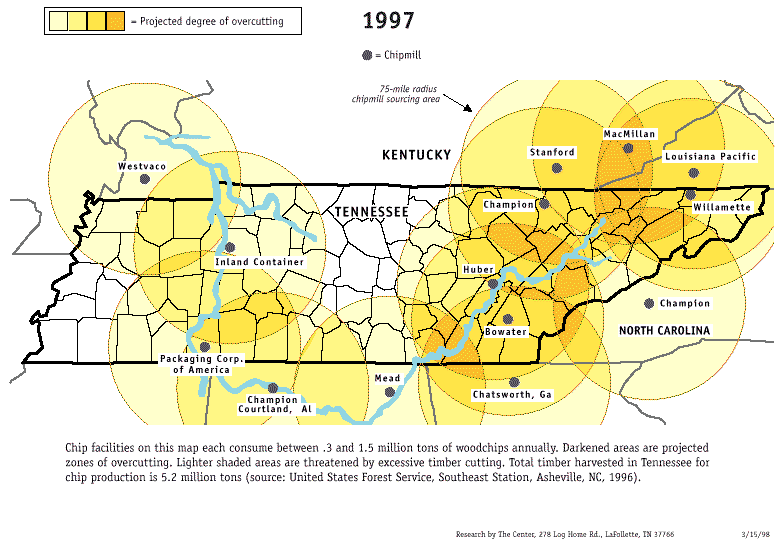| |

I. Roundwood (Logs) Cut for Pulp in Tennessee
(all statistics from USFS, Southern
Research Station)
- 1989: 601,000 cords softwood + 397,000 cords
hardwood=2.7 million green tons
-
- 1996: 682,000 cords softwood + 834,000 cords
hardwood + 350,000 cords hardwood (log loading
ports)=5.2 million green tons*
-
- This is a 93% increase in total consumption
(about 11% yearly) in 7 years.
-
- Increase from 19891996 Softwoods (cords): 601,000
to 682,000 a 13% increase, or about 1.5% yearly;
-
- Increase from 19891996 Hardwoods (tons): 1.1
million tons to 3.3 million tons (2.3 million
tons plus 1 million tons from whole log ports) an
increase of 200% or an average 18% increase
yearly.
-
- * USFS figure for 1996 is 4.2 million tons. Tony
Johnson, author of this report states that this
does NOT take into account another estimated 1
million tons of logs cut in Tennessee and shipped
out of the state from 12 whole log ports (see map
3) for chipping.
-
Summary: 1996 total timber cutting in Tennessee for
wood chips—5.2 million tons—has almost doubled
since 1989. Most of this increase is in hardwoodcutting
of hardwood timber for chips has TRIPLED in these seven
years.
II. The Impact of Timber Cutting on Tennessees Forest
Land
The following projections show the number of
Tennessees forest acres that will be impacted by pulpwood
harvesting for the near future under two different growth
assumptions: a zero-growth scenario, where 1996
production levels are maintained for the next 20 years
and a more realisticyet conservativeassumption of
sustained growth, computing harvesting based on an annual
growth rate of 9%. (This is an increase of only one-half
of the actual 18% yearly growth that occurred between
1989 and 1996. Although the assumption of zero growth is
not feasible, the numbers provide a useful baseline, a
snapshot at current cutting levels.)
Acreage Needed to Maintain Production at 1996 Levels:
Hardwoods: 3,300,000 tons/40 tons per acre=82,000
acres per year
- In 20 years, we would need about 1.64 million
acres of hardwood forest clearcut to supply chips
for the market.
-
Softwoods: 1,248,000 tons=estimated yield from 16,000
acres of plantation (Using Bowater figures of 78 tons per
acre for plantations)
- Estimated yield from older pine stands (not yet
converted to plantations) at 40 tons per acre
(plus sawlogs) on an estimated 16,000
acres=640,000 tons.
-
- About 32,000 clearcut acres produces a years
(1996) supply of softwood for pulp. In the next
20 years we would need 640,000 total acres of
pine in a clearcut rotation to maintain this
level.
-
* 2.3 million acres=total acreage
needed to maintain 1996 production level
Acreage Needed to Support an annual Growth Rate of 9%
in Hardwood Consumption:
- Hardwood consumption grew at the rate of 18% per
year in the past seven years. Global demand for
hardwood chips is increasing, and supplies of
high-quality hardwood chips are not plentiful in
most other parts of the world. Our regions
existing chipmills arent even operating at full
capacity, and new mills are coming on line. So
long as the Tennessee Division of Forestry
recommends clearcutting as the preferred option
for harvesting hardwoods, clearcutting hardwoods
for chips will doubtless continue to increase
dramatically. Even the modest growth rate of 9%
over the next twenty years would result in total
acreage of hardwood forest in clearcut rotation
of almost 5 million acres in 20 years (2016).
-
- Softwoods: Softwood (pine) harvesting for pulp
increased slightly from 1989 to 1996. As older,
natural pine stands are cut, some will be
converted to plantations, whichin the short term,
at leastproduce more tons per acre. For the
softwood harvest to increase by 60100% in the
next 15 to 20 years, it will require some
increase in annual acreage, up to 1 million total
acres of pine in clearcut rotation.
-
* 6 million acres=total acreage
needed by 2016, presuming modest growth rate
* In actuality, net forested land
available for harvest is about 11 million acres when you
exclude steep land, protected land, stream sides, land
owned by those who refuse to harvest their land, land in
close proximity to developed land, and land that is
extremely unproductive.
Summary: Six million acres of Tennessees forested
land13 million acres total* could be clearcut in the next
20 years. Not only would it change our landscape
dramatically, but the effects on local environments and
on the hardwood lumber industry would be disastrous. Our
forest has limits, and the sooner we take this seriously,
the better we will be able to take appropriate action.
3/98 Table Of Contents
|
|




